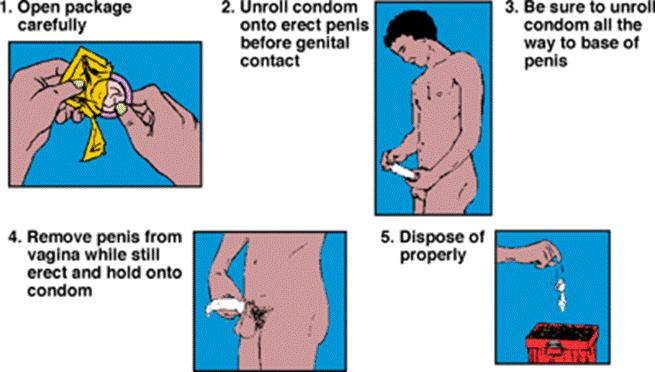While obtaining a health history from a male adolescent during a good check-up, the nurse assesses his sexual behavior and risk for sexually transmitted infections. Based on the information, the nurse plans to teach the adolescent about using a condom. What statement would the nurse include in the teaching plan?
"Store your condoms in your wallet so they are ready for use."
"Use petroleum jelly with a latex condom for extra lubrication."
"Put the condom on before engaging in any genital contact."
"You can reuse a condom if it's within 3 hours."
The Correct Answer is C
Choice A: "Store your condoms in your wallet so they are ready for use." This statement is not correct and should not be included in the teaching plan. Storing condoms in a wallet can damage them by exposing them to heat, friction, or puncture. Damaged condoms can break or leak during sexual activity and increase the risk of STIs or pregnancy.
Choice B: "Use petroleum jelly with a latex condom for extra lubrication." This statement is not correct and should not be included in the teaching plan. Using petroleum jelly or any oil-based lubricant with a latex condom can weaken the latex material and cause it to break or slip off. Only water-based or silicone-based lubricants should be used with latex condoms.
Choice C: "Put the condom on before engaging in any genital contact." This statement is correct and should be included in the teaching plan. Putting the condom on before engaging in any genital contact can prevent the transmission of STIs or pregnancy by avoiding contact with pre-ejaculate fluid, semen, or vaginal fluid.
Choice D: "You can reuse a condom if it's within 3 hours." This statement is not correct and should not be included in the teaching plan. Reusing a condom can increase the risk of STIs or pregnancy by exposing the partner to residual fluid, bacteria, or sperm. A new condom should be used for each sexual act.

Nursing Test Bank
Naxlex Comprehensive Predictor Exams
Related Questions
Correct Answer is D
Explanation
Choice A: Breast milk is not the correct answer because it is not a route of transmission for syphilis. Syphilis is caused by a bacterium called Treponema pallidum, which cannot survive in breast milk. However, breastfeeding mothers with syphilis should be treated with antibiotics to prevent other complications.
Choice B: The birth canal is not the correct answer because it is not a route of transmission for syphilis. Syphilis can be transmitted through sexual contact, but not through vaginal delivery. However, pregnant women with syphilis should be screened and treated before delivery to prevent congenital syphilis in their newborns.
Choice C: Amniotic fluid is not the correct answer because it is not a route of transmission for syphilis. Syphilis cannot cross the amniotic membrane, which protects the fetus from infections in the uterus. However, pregnant women with syphilis should be monitored for signs of fetal distress or premature rupture of membranes.
Choice D: Placenta is the correct answer because it is a route of transmission for syphilis. Syphilis can cross the placenta, which connects the mother and the fetus through blood vessels. This can result in congenital syphilis, which can cause serious problems such as stillbirth, miscarriage, low birth weight, deformities, or neurological damage in newborns.
Correct Answer is A
Explanation
Choice A: Do not apply heat to the area of irradiation. This instruction is correct and should be included in the teaching. Applying heat to the area of irradiation can increase inflammation, pain, or burning sensation on the skin. The client should avoid heat sources such as hot water, heating pads, or sun exposure in the area of irradiation.
Choice B: Use an antibiotic ointment to treat skin breakdown. This instruction is not correct and should not be included in the teaching. Using an antibiotic ointment to treat skin breakdown can cause allergic reactions, infection, or interference with radiation therapy. The client should consult with her provider before using any topical products in the area of irradiation.
Choice C: Lubricate the skin with hypoallergenic lotion. This instruction is not correct and should not be included in the teaching. Lubricating the skin with hypoallergenic lotion can cause irritation, infection, or interference with radiation therapy. The client should avoid applying any lotions, creams, or oils on the area of irradiation unless prescribed by her provider.
Choice D: Do not wash the area of irradiation. This instruction is not correct and should not be included in the teaching. Washing the area of irradiation can help prevent infection, remove dead skin cells, and reduce odor. The client should wash the area of irradiation gently with mild soap and water, pat it dry, and avoid rubbing or scrubbing.

Whether you are a student looking to ace your exams or a practicing nurse seeking to enhance your expertise , our nursing education contents will empower you with the confidence and competence to make a difference in the lives of patients and become a respected leader in the healthcare field.
Visit Naxlex, invest in your future and unlock endless possibilities with our unparalleled nursing education contents today
Report Wrong Answer on the Current Question
Do you disagree with the answer? If yes, what is your expected answer? Explain.
Kindly be descriptive with the issue you are facing.
